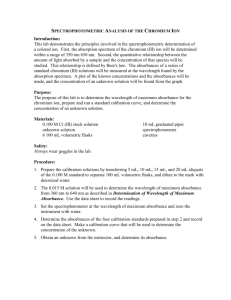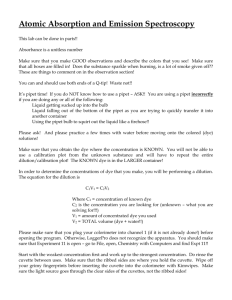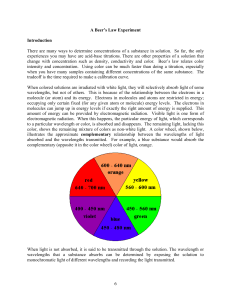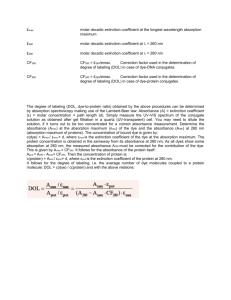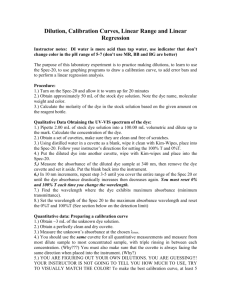A Beer's Law Experiment Introduction
advertisement
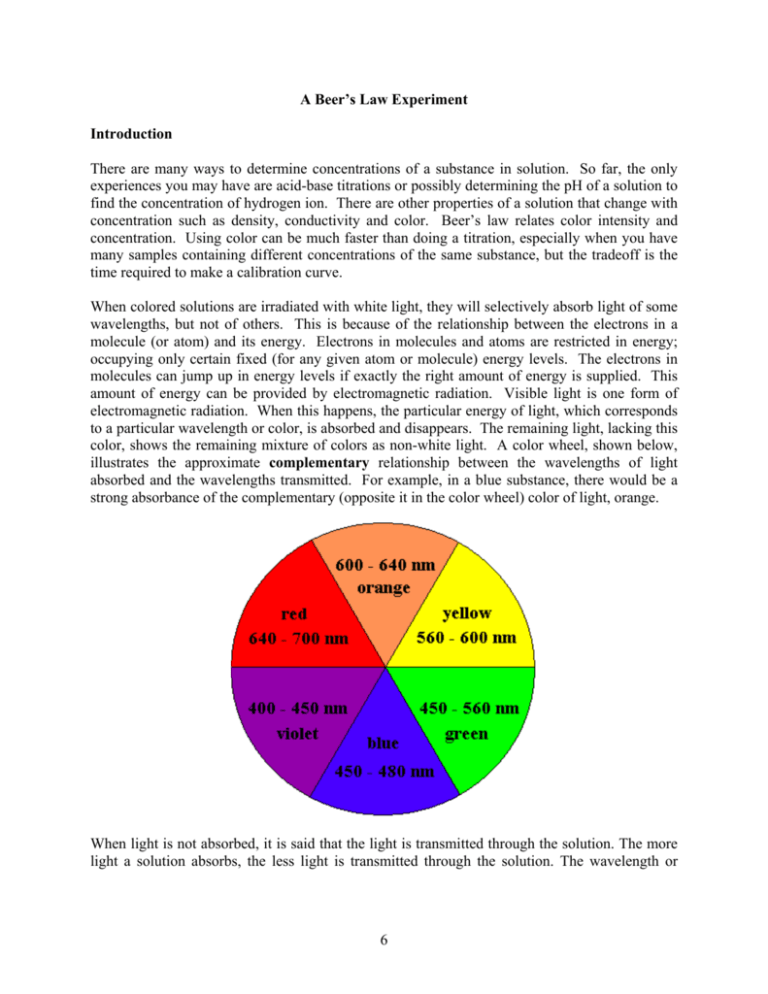
A Beer’s Law Experiment Introduction There are many ways to determine concentrations of a substance in solution. So far, the only experiences you may have are acid-base titrations or possibly determining the pH of a solution to find the concentration of hydrogen ion. There are other properties of a solution that change with concentration such as density, conductivity and color. Beer’s law relates color intensity and concentration. Using color can be much faster than doing a titration, especially when you have many samples containing different concentrations of the same substance, but the tradeoff is the time required to make a calibration curve. When colored solutions are irradiated with white light, they will selectively absorb light of some wavelengths, but not of others. This is because of the relationship between the electrons in a molecule (or atom) and its energy. Electrons in molecules and atoms are restricted in energy; occupying only certain fixed (for any given atom or molecule) energy levels. The electrons in molecules can jump up in energy levels if exactly the right amount of energy is supplied. This amount of energy can be provided by electromagnetic radiation. Visible light is one form of electromagnetic radiation. When this happens, the particular energy of light, which corresponds to a particular wavelength or color, is absorbed and disappears. The remaining light, lacking this color, shows the remaining mixture of colors as non-white light. A color wheel, shown below, illustrates the approximate complementary relationship between the wavelengths of light absorbed and the wavelengths transmitted. For example, in a blue substance, there would be a strong absorbance of the complementary (opposite it in the color wheel) color of light, orange. When light is not absorbed, it is said that the light is transmitted through the solution. The more light a solution absorbs, the less light is transmitted through the solution. The wavelength or 6 group of wavelengths when a solution absorbs light can be determined by exposing the solution to monochromatic light of different wavelengths and recording the responses. light source <____> pathlength original intensity transmitted intensity If light of a particular wavelength in not absorbed, the intensity of the beam directed at the solution (Io) would match the intensity of the beam transmitted by the solution (It). If some of the light is absorbed, the intensity of the beam transmitted through the solution will be less than that of the original intensity. The ratio of It and Io can be used to indicate the percentage of incoming light absorbed by the solution. This is called the percent transmittance. I %T = t x 100 Io (1) A more useful quantity is the absorbance (A) defined as A = –log(%T/100) (2) The higher the absorbance of light by a solution, the lower the percent transmittance. The wavelength at which absorbance is highest is the wavelength to which the solution is most sensitive to concentration changes. This wavelength is called the maximum wavelength or λmax. In the first part of this experiment, you will determine λmax of one of the artificial food dyes by plotting absorbance versus wavelength. For an example of how this plot would look, refer to Figure I. By looking at Figure I, it can be determined that λmax for a purple dye is approximately at 570 nm. Once you determine λmax, you can demonstrate how three variables influence the absorbance of a solution. They are the concentration (c) of the solution, the pathlength (b) of the light through the solution (also called the cell length) and the molar absorptivity (ε); the sensitivity of the absorbing species to the energy of λmax. The pathlength, unless stated otherwise, is fixed at 1.00 cm. The molar absorptivity depends on the substance, the solvent and λ. The units for molar absorptivity are L/mole·cm for concentration in mole/L. Beer’s law states the following: A = εbc (3) With this equation (a calibration curve based on it), you can determine an unknown concentration or estimate what the absorbance of a certain solution will be as long as three of the four values in the equation are known. 7 In the second part of this experiment, you will determine the molar absorptivity of the dye chosen in the first part in aqueous solution. You will vary the concentration of your solution and make a calibration plot of absorbance versus concentration. Absorbance is linearly related to concentration. To determine the molar absorptivity, take the slope of the line from the plot and divide by the pathlength. For an example of a calibration plot, refer to Figure II on page 12. It should be noted that there are conditions where deviations from Beer’s law occur. This happens when concentrations are too high or because of lack of sensitivity of instrumentation. In the third part of the experiment, you will determine the mass percent of your chosen dye in a consumable product sample. Currently only seven non-natural compounds are certifiable for use in food in the United States. The structures and formulae are given below: Dye Common name Chemical Formula Color Red #3 Erythrosine Na2C20H6I4O5 Cherry red I I +- Na O O O I I - + COO Na Red #40 Na2C18H14N2O8S2 Allura Red AC OCH3 Orange-red OH N N +- Na SO3 CH3 - + SO 3 Na Blue #1 Na2C37H34N2O9S3 Brilliant Blue FCF Bright blue N SO3 - + SO3 Na - + N - + SO3 Na Blue #2 Na2C16H8N2O8S2 Indigotine + - Na O O3S Tartrazine H N - N H Yellow #5 Royal blue + SO3 Na O Na3C16H9N4O9S2 Lemon yellow - OH +- Na O 3S N N N N - + COO Na 8 + SO 3 Na Yellow #6 Sunset Yellow Na2C16H10N2O7S2 Orange OH N N +- Na SO3 - + SO 3 Na Green #3 Fast Green FCF Na2C37H34N2O10S3 Sea green N SO3 - + SO3 Na - + N HO - + SO3 Na You will accurately weigh a sample containing a dye, extract the dye to make a solution and measure its absorbance. Using the calibration curve you obtained in the second part, you can determine the concentration of the dye from the graph. Absorbance versus wavelength plot to determine λmax. Absorbance of Purple Dye versus Wavelength 1.000 0.900 0.800 0.700 0.600 Absorbance Figure I: 0.500 0.400 0.300 0.200 0.100 0.000 400 450 500 550 Wavelength (nm) 9 600 650 700 Figure II: Example of a calibration curve. Line should go through the point 0,0. At 0.00 M concentration, the absorbance is calibrated to be zero. This will almost always be one of your points. The slope of the line is ε and R2 gives the fit (should be 1). Calibration Curve of Purple Dye at 572 nm 1.000 0.900 0.800 0.700 Absorbance 0.600 0.500 3 y = 9.80 x 10 x 2 R = 0.994 0.400 0.300 0.200 0.100 0.000 0.00E+00 2.00E-05 4.00E-05 6.00E-05 8.00E-05 1.00E-04 Concentration (M) Procedure Part I 1. Obtain a sample of red #40, blue #1, blue #2, yellow #5 or yellow #6 stock solution. Record the name, concentration and color of the solution you selected. 2. Fill a cuvette about half-full of the stock solution and another cuvette with a similar amount of distilled water (the blank). 3. Starting at a wavelength of 400 nm and working your way up to 700 nm, measure the absorbance of the stock solution at 25 nm intervals. The wavelength is selected using the dial on the top of the instrument; to the right of the sample compartment. Set the Spectronic 20 to 0.0 %T (with nothing in the sample compartment) by adjusting the LEFT dial on the front of the instrument. 10 Place the blank cuvette into the compartment with the line on the cuvette aligned with the mark on the compartment (this keeps the pathlength constant). Adjust to 100.0 %T with the dial on the RIGHT. Some of the digital Spectronic 20's have a filter lever at the bottom. Make sure the lever is in the correct wavelength range. Remove the blank and place the sample cuvette in the compartment and align as you did the blank. Record absorbance (A) by pushing the MODE button once. Push the MODE button three more times to return to %T mode. Change the wavelength and repeat the zero and 100.0 %T adjust. 4. When you have readings for the entire spectrum, determine the wavelength with the greatest absorbance. Take readings at 5 nm intervals a little before and after this wavelength. For example, if the maximum absorbance was found at 450 nm, then to get a more accurate reading of λmax, take absorbance readings at 440, 445, 455 and 460 nm. A graph of A versus λ (in Data Treatment and Discussion) will look like Figure I with a peak at the dye’s λmax. Part II 1. Determine (with calculations) how to make at least four dilutions of the original solution using 5-, 10-, 20- and 25-mL pipets and your two 100-mL and two 50-mL volumetric flasks that will give well spread out data points on the calibration curve (Figure II). 2. Make the required solutions as accurately as possible. 3. Set the Spec 20 to the estimated λmax determined in Part I and measure the absorbance of the four solutions and the original stock solution. Check the blank before each measurement. Part III Extracting Food Dye from Froot Loops® Cereal 1. Select the proper color Froot Loops® rings that contain the food dye that you used in Part I and II of the experiment. Ask the instructor for details. Record the color chosen. 2. Accurately (analytical balance) determine the mass of 10 rings in a tared 50-mL beaker. 3. Grind the rings to a fine powder with a ceramic mortar and pestle. 4. Measure 25.0 mL of distilled water in a graduated cylinder and use the water to rinse the Froot Loops® powder into a 100-mL beaker. Rinse the mortar and pestle into the beaker with a little water from a wash bottle. 5. Using a hot plate, heat, with stirring, the Froot Loops® slurry until it just starts boiling. Remove from the hot plate and let the mixture cool to the touch. 11 6. Add 25.0 mL (from dispenser) of acetone to the cooled slurry. 7. Stir the slurry/acetone mixture on a cooled stirrer-hotplate until the solids settle easily and give a clear (not colorless) solution. This should be done for at least 5 minutes. 8. Letting the mixture settle, decant and filter the solution in the beaker directly into a 100mL volumetric flask using fast, flutted 11.0 cm filter paper and a funnel. Keep as much of the solids in the beaker as possible to prevent the filter from clogging. Use a ring to support the funnel. Make sure the tip of the funnel is well in the neck of the volumetric flask so you do not lose any solution. 9. After nearly all the solution has drained into the flask, rinse the solids in the beaker once with about 10.0 mL of 1:1 acetone/water, let the mixture settle, then filter as before. 10. Fill the flask to the mark with 1:1 acetone/water. 11. Measure the absorbance of the solution at the λmax used in part II. Use 1:1 acetone/water as the blank. Questions 1. 2. Make a plot of absorbance versus wavelength using the data below. Determine the λmax (within 1 nanometer using a second graph of a close-up of the peak) of this compound. Include the dye color in the title. λ (nm) A λ (nm) A 400 425 450 475 500 525 550 555 560 565 0.429 0.208 0.196 0.271 0.406 0.650 0.871 0.900 0.928 0.954 570 575 580 585 600 625 650 675 700 0.974 0.966 0.936 0.878 0.599 0.208 0.056 0.013 0.003 Fill in the missing values in the "A" column (using equation 2) and make a plot of A versus concentration of dye using the following data. Fit a trendline to the Beer’s law plot (forced through 0, 0). What is the name of and the numerical value of the slope of the trendline? What is the R2 value? Be sure to give the correct units and number of significant figures. 12 [Dye] (M) %T A 0.00 7.35E-07 1.47E-06 1.84E-06 3.68E-06 7.35E-06 100 84.2 69.8 65.2 43.4 20.4 0 ? 0.156 ? 0.362 ? Data Treatment and Discussion Include the following information, with an appropriate discussion. Show sample calculations. 1. Plot A versus λ. Include all the data that you recorded for your dye. Make sure the plot is done properly: a descriptive title, axes labeled with units, data points clearly indicated, smooth line through points (you are not intending to demonstrate a mathematical relationship). Find λmax to 3 significant figures using a close-up plot. 2. Show all the calculations for the determination of the concentrations of the dilute solutions used to make the calibration curve. The concentrations are determined from: M new 3. mole = L mole x (pipet volume) L/ L/ (volumetric flask volume) L M old Plot A versus concentration. Construct this calibration curve with the four dilutions, the blank (an absorbance of 0.0 at 0.0 M concentration) and the original solution for a total of 6 points. Only when the theoretical relationship between the data points is not a known function do you connect the points (as in 2. a. and b. above). In this case, just fit a trendline to the clearly indicated data points. Make sure you select the proper function to fit. Remove the gray background and any gridlines and adjust the font size for all your labels. Use the whole page. Include the equation of the line and the R2 value on the plot. Force the trendline to go through 0,0. 4. Calculate the concentration of the solution in Part III using Beer’s Law (ε is the slope of the calibration curve). Draw, by hand, the point on the plot that corresponds to this value. 5. Knowing the concentration and volume of the solution, the molar mass of the dye, and the mass of the Froot Loops sample, calculate the mass percent of the dye in the sample. 13 Conclusion λmax of the dye, the molar absorptivity of the dye (don’t forget the units), concentration of the dye (be sure to include which dye) in the Froot Loop extract (indicate the color of the Froot Loop used), and the mass percent of dye in your sample are to be given in the first line of the conclusion. Then address the following: Does your solution obey Beer's Law? How do you know? approximately which concentration range of the plot is not linear? If not, determine What is an advantage of colorimetric over titration determinations of concentrations? What is a disadvantage? 14


